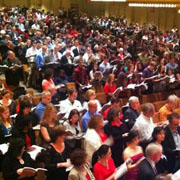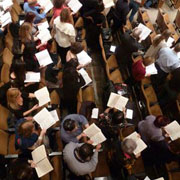VOA标准英语2011--'Messiah' Holiday Tradition Marks 44th Year(在线收听)
'Messiah' Holiday Tradition Marks 44th Year
The holidays are here, and with them, a crescendo of special music reserved for this season.
But along with “Jingle Bells,” “Silent Night” and “Santa Baby,” towers the “Messiah.” Eighteenth century composer George Frederick Handel penned the two-hour choral masterpiece in just under three weeks.
It is performed all around the country, by church, school and community choirs.
In many cases, the audience is invited to sing along. At the 44th annual "Messiah Sing-In” in New York, nearly 2,000 people gathered to sing with professional soloists in a marathon celebration of community and the Christmas spirit.
Lincoln Center’s vast and glittering Avery Fisher Hall is filled nearly to capacity every year for the sing-in. Accompanied only by an organ, music lovers join their voices with high school and community choruses to bring Handel’s “Messiah” to life.
Each of the 17 chorus sections is conducted by a different well-known conductor, and the solos are sung by well-known professionals. But National Chorale Music Director Martin Josman, who created the first sing-in in 1967 and acts as the evening’s emcee, says that the audience is the true star.
 |
| This year’s "Messiah Sing-In" at Lincoln Center was attended by nearly 2,000 people. |
“The emphasis is on the public that sings," he says. "There are no auditions; there are no rehearsals; there are no requirements for coming to the sing-in. You have to buy your tickets so we can pay the rent. Besides, that, anybody who wants to come can come.”
And come they have, for 44 years. Bruce and Scott Van Hoven have attended the Messiah Sing-Ins regularly for a quarter century.
"It’s the greatest piece of choral music ever written and I’ve been doing this since I was 14," says Bruce. "And it’s kind of a family tradition. My grandfather performed in a local production of the Messiah for years, so I am just carrying that on a little bit. We always try to bring some other people for their first time."
"And it just keeps growing and growing every year," Scott says. "It’s a great way to really get the Christmas season going.
Nancy Reid is a sing-In first-timer. She is here with her husband and two friends, both choristers, who told them about the sing-in’s magic. She wants to relive the thrill she felt as a child in Ohio when her parents’ friends invited local musicians and neighbors to their home to sing selections from the Messiah’s choral movements.
 |
| Most of the "Messiah Sing-In" participants bring their own scores. |
“And we would sing and sing and sing," Reid says. "I don’t read a line of music but I’ve got these melodies emblazoned on my memory from when I was a kid. So we went immediately out and bought a couple of scores for ourselves and we were just saying ‘God help the people in front of us’ because we have very loud voices.”
In other cities that host "Messiah" sing-alongs, the singers are arranged around the venue according to their vocal parts. But Josman says New Yorkers prefer to sing with the people they came with or what they call "scrambled” in choral jargon. That’s good he says, because the sing-in is not a performance, but a community celebration.
“And people who make music very quickly get to feel at home with others who are in the process," he says. "Whether they be vocalists or instrumentalists, there is a kinship of sharing the musical experience. And also we say, ‘We are in this marvelous hall. Let’s fill this place with glorious sound.’ And we do.”
Well, the truth is, not all the sound is glorious. But that doesn’t bother the professionals.
"I’m someone who believes that if someone goes in and they sing with passion and they really enjoy what they’re doing, music will follow," says professional baritone solist James Bobick. "Everybody is there because they love The Messiah as much as we do and it’s a wonderful opportunity for us to share this love of an incredible work. It’s this unique energy."
"Yeah, yeah, yeah, "Messiah" brings that joy every Christmas," soprano Zulimar Lopez-Hernandez says.
Eyes that have been bright for the two hours of near continuous singing tonight manage to light up even more as the organ introduces the “Halleluiah Chorus,” and for the 44th year in a row, the sing-in singers give the Messiah’s popular climax everything they’ve got.
“Halleluiah” means “praise Him” in ancient Aramaic, but today, it translates into hope and joy in any language.